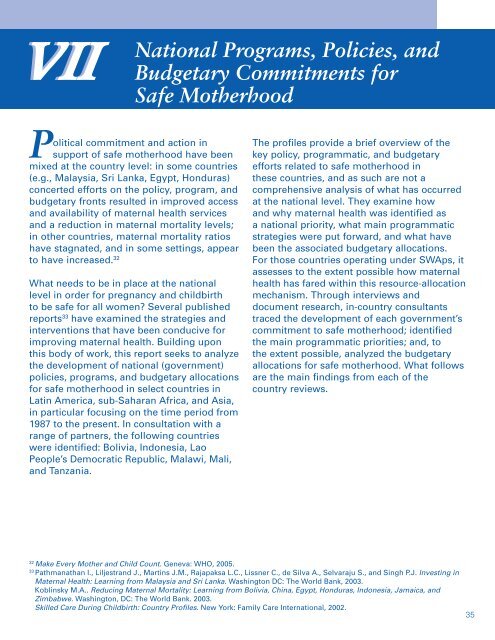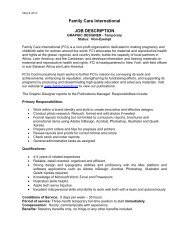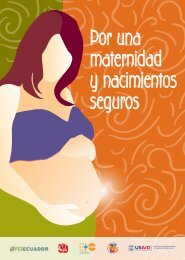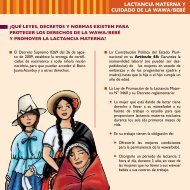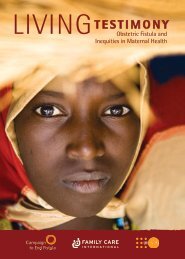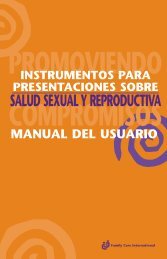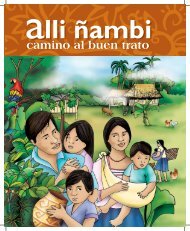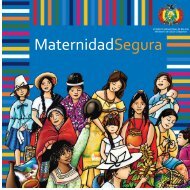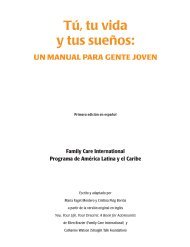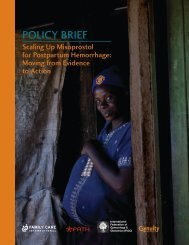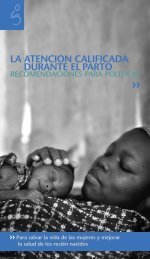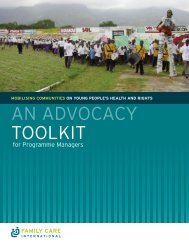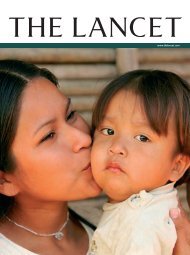Safe Motherhood: A Review - Family Care International
Safe Motherhood: A Review - Family Care International
Safe Motherhood: A Review - Family Care International
You also want an ePaper? Increase the reach of your titles
YUMPU automatically turns print PDFs into web optimized ePapers that Google loves.
VII VII<br />
National Programs, Policies, and<br />
Budgetary Commitments for<br />
<strong>Safe</strong> <strong>Motherhood</strong><br />
Political commitment and action in<br />
support of safe motherhood have been<br />
mixed at the country level: in some countries<br />
(e.g., Malaysia, Sri Lanka, Egypt, Honduras)<br />
concerted efforts on the policy, program, and<br />
budgetary fronts resulted in improved access<br />
and availability of maternal health services<br />
and a reduction in maternal mortality levels;<br />
in other countries, maternal mortality ratios<br />
have stagnated, and in some settings, appear<br />
to have increased. 32<br />
What needs to be in place at the national<br />
level in order for pregnancy and childbirth<br />
to be safe for all women? Several published<br />
reports 33 have examined the strategies and<br />
interventions that have been conducive for<br />
improving maternal health. Building upon<br />
this body of work, this report seeks to analyze<br />
the development of national (government)<br />
policies, programs, and budgetary allocations<br />
for safe motherhood in select countries in<br />
Latin America, sub-Saharan Africa, and Asia,<br />
in particular focusing on the time period from<br />
1987 to the present. In consultation with a<br />
range of partners, the following countries<br />
were identified: Bolivia, Indonesia, Lao<br />
People’s Democratic Republic, Malawi, Mali,<br />
and Tanzania.<br />
The profiles provide a brief overview of the<br />
key policy, programmatic, and budgetary<br />
efforts related to safe motherhood in<br />
these countries, and as such are not a<br />
comprehensive analysis of what has occurred<br />
at the national level. They examine how<br />
and why maternal health was identified as<br />
a national priority, what main programmatic<br />
strategies were put forward, and what have<br />
been the associated budgetary allocations.<br />
For those countries operating under SWAps, it<br />
assesses to the extent possible how maternal<br />
health has fared within this resource-allocation<br />
mechanism. Through interviews and<br />
document research, in-country consultants<br />
traced the development of each government’s<br />
commitment to safe motherhood; identified<br />
the main programmatic priorities; and, to<br />
the extent possible, analyzed the budgetary<br />
allocations for safe motherhood. What follows<br />
are the main findings from each of the<br />
country reviews.<br />
32 Make Every Mother and Child Count. Geneva: WHO, 2005.<br />
33 Pathmanathan I., Liljestrand J., Martins J.M., Rajapaksa L.C., Lissner C., de Silva A., Selvaraju S., and Singh P.J. Investing in<br />
Maternal Health: Learning from Malaysia and Sri Lanka. Washington DC: The World Bank, 2003.<br />
Koblinsky M.A.. Reducing Maternal Mortality: Learning from Bolivia, China, Egypt, Honduras, Indonesia, Jamaica, and<br />
Zimbabwe. Washington, DC: The World Bank. 2003.<br />
Skilled <strong>Care</strong> During Childbirth: Country Profiles. New York: <strong>Family</strong> <strong>Care</strong> <strong>International</strong>, 2002.


